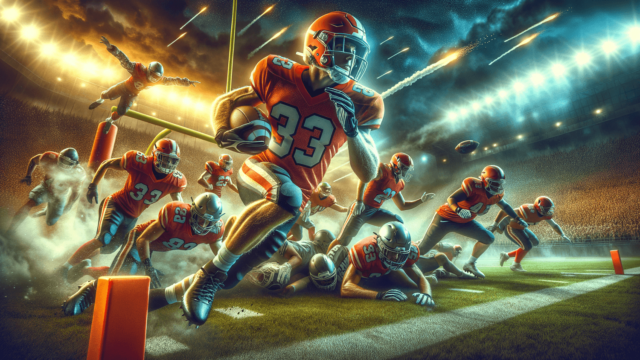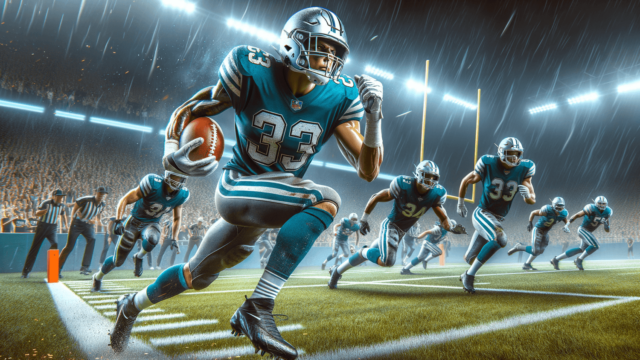
The flat in football refers to an area on the field close to the sidelines, extending approximately 5 yards from the line of scrimmage. Offensive plays can target this area with short passes to exploit defensive weaknesses, while defensive schemes aim to cover the flats to prevent successful plays.
Understanding the Flat in Football
The flat in football is an area of the field extending around five yards from the line of scrimmage and adjacent to the sidelines on both sides. It is a critical region for both offensive and defensive strategies, often exploited to create mismatches and take advantage of weaknesses in the opposing team’s defense.
Offensive Strategies in the Flat
Short Passes
Offensive plays often target the flat with short passes to running backs, wide receivers, or tight ends. These quick passes place pressure on the defense by forcing them to cover multiple threats, thereby opening up areas elsewhere on the field for more significant gains.
Screen Passes
A popular offensive strategy in the flat is the screen pass. A screen pass is a quick, short pass to a running back or wide receiver, who, supported by blockers, attempts to gain yardage in the open space created by the flat.
Defensive Coverage of the Flat
Zone Defense
In a zone defense, a linebacker or defensive back is assigned the responsibility of covering the flat, helping to prevent short passes and limit the offensive team’s gains. This coverage is crucial, as it forces the offense to look for alternative options, reducing the likelihood of successful plays in the flat.
Man-to-Man Defense
In man-to-man defense, a specific defender is assigned to cover a specific offensive player. When defending the flat, the defender’s goal is to prevent their assigned player from catching the ball or limiting their yardage after the catch. This strategy can be advantageous when there’s a significant mismatch between the assigned defenders and the offensive players they are covering.
Types of Flat Routes in Football
Various offensive routes and plays target the flat, each with unique characteristics aiming to exploit specific defensive weaknesses. Some of these routes include:
Swing Route
A swing route involves a running back starting in the backfield and running towards the flat, parallel to the line of scrimmage. The quarterback then throws a short pass to the running back, who tries to outpace defenders and gain yards downfield. This route exploits mismatches in speed between the running back and any defenders covering the flat.
Slant Route
In a slant route, a wide receiver or tight end lines up on the line of scrimmage and sprints forward for a couple of yards. They then cut diagonally towards the center of the field, creating a target for a quick pass from the quarterback. This route aims to exploit the defender’s positioning and create separation between the receiver and the defender in the flat.
Wheel Route
A wheel route involves a running back or wide receiver starting in the backfield or close to the line of scrimmage and running a short, curved route towards the sideline. They then turn upfield along the sideline, essentially running a circle around the defender in the flat. This route can often lead to big gains if the defender gets caught out of position.
How Defenses Counter Flat Routes
Defensive coordinators must adapt their strategies to minimize the offensive gains in the flat. Key adjustments include:
Defensive Line Containment
Defenders on the line of scrimmage are responsible for containing the edge and preventing offensive players from running around them in the flat. They must maintain their position and force running backs and receivers to stay within the tackles, where additional defenders can assist in making the tackle.
Defender Depth Adjustment
Defenders responsible for covering the flat may adjust their depth to better defend against specific plays or routes. Shallow positioning can disrupt short, quick passes, while deeper coverage may limit the potential gains on routes that target deeper areas in the flat.
FAQ: Understanding the Flat in Football
After learning about the flat in football, you might have some questions about its importance, as well as how it affects offensive and defensive strategies. Here, we answer five common questions related to the flat:
Why is the flat in football important?
The flat is significant because it serves as a common target for offensive plays that exploit defensive weaknesses. By targeting this area with short passes, offenses can force the defense to cover multiple threats, opening up other areas of the field for more significant gains.
What are some offensive plays that target the flat?
Offensive plays that target the flat include short passes to running backs, wide receivers, or tight ends, screen passes, swing routes, slant routes, and wheel routes. Each of these plays aims to take advantage of mismatches or create separation in the flat to gain yardage downfield.
How do defenses adjust to cover the flat?
Defenses use both zone and man-to-man coverage to cover the flat. In a zone defense, a linebacker or defensive back is assigned to the area, while man-to-man coverage assigns a defender to a specific offensive player. Defenses may also adjust the depth of their coverage to counter specific flat routes or plays.
What is the role of defensive linemen in defending the flat?
Defensive linemen help contain the edge of the field, preventing offensive players from running around them and gaining yardage in the flat. Maintaining their position on the line of scrimmage, they force running backs and receivers to stay within the tackles, making it easier for other defenders to make the tackle.
How can teams exploit weaknesses in the defense using the flat?
Teams can exploit weaknesses in the defense by targeting the flat with various offensive plays and routes to create mismatches or confusion. For example, a fast running back catching a short pass in the flat might be able to outpace a slower linebacker, while a savvy receiver running a slant route could create separation from a defender, making it easier to connect with a quick pass from the quarterback.
Featured Posts
- No pillar pages found.





